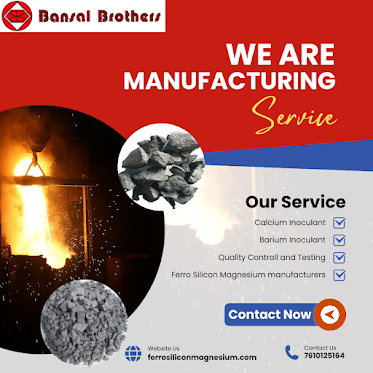Optimizing Cast Iron Production with Barium Inoculant
In the realm of cast iron manufacturing, obtaining the correct mix of strength, durability, and workability is a perpetual struggle. One essential element in this delicate dance is the use of inoculants. These compounds, added to molten iron, assist regulate the solidification process, ensuring the finished product has the correct microstructure and qualities. Among numerous inoculants, barium stands out for its distinct advantages. Let's dig into how barium inoculant may enhance cast iron manufacturing.
The Role of Inoculants in Cast Iron Production
What Are Inoculants?
Inoculants are materials applied to molten iron to change its microstructure during solidification. They encourage the production of tiny, uniformly dispersed graphite flakes in gray iron or nodules in ductile iron, which are critical for the mechanical qualities of the final product. Without inoculants, cast iron may create undesired carbide structures, resulting to brittle and weak castings.
Why Barium?
Barium is a relatively recent addition to the family of inoculants but has swiftly acquired favor owing to its unique features. When used in conjunction with other elements like calcium and aluminum, barium may considerably boost the efficacy of the inoculation process.
Benefits of Barium Inoculant Improved Nodule Count
One of the key advantages of utilizing barium inoculant is the rise in nodule count in ductile iron. Higher nodule counts result in enhanced mechanical qualities, such as greater tensile strength and better elongation. This is because the nodules function as crack arrestors, inhibiting the development of fractures and boosting the toughness of the iron.
Reduced Chill Tendency
Chill propensity refers to the creation of hard carbide structures in cast iron, which may make the material harder to manufacture and lower its overall quality. Barium inoculant serves to lessen the chill tendency by stimulating the development of graphite instead of carbides, resulting to softer and more machinable cast iron.
Enhanced Machinability
Cast iron treated with barium inoculant tends to be more machinable owing to the decrease in carbide production and the better dispersion of graphite. This implies reduced wear and tear on cutting tools and better machining processes, which may contribute to cost savings in the production process.
Consistent Quality
Barium inoculants lead to more consistent quality in cast iron manufacturing. By assuring a homogeneous microstructure, these inoculants assist producers obtain predictable and reproducible outputs, minimizing the chance of faults and enhancing overall efficiency.
How to Use Barium Inoculant Dosage and Timing
The success of barium inoculant relies on the precise dose and time of addition. Generally, it is added in modest amounts, generally ranging from 0.1% to 0.2% of the molten iron weight. The inoculant should be introduced immediately before pouring to guarantee optimal efficacy, since the advantages might lessen if the molten iron is stored for too long before casting.
Combination with Other Inoculants
Barium is commonly used in conjunction with other inoculants as calcium, aluminum, and zirconium. These combinations may have synergistic benefits, significantly increasing the characteristics of the cast iron. For example, a blend of barium and calcium may increase both nodule count and chill reduction more efficiently than each element alone.
Case Studies and Real-World Applications
Automotive Industry
In the automobile sector, the demand for robust, durable, and lightweight components is crucial. Barium inoculant has been effectively utilized to make high-quality ductile iron components, such as engine blocks and suspension parts, which need outstanding mechanical characteristics and machinability.
Heavy Machinery
Manufacturers of heavy equipment also profit from the usage of barium inoculant. Components including gears, bearings, and housings constructed from barium-treated cast iron display improved strength and wear resistance, necessary for the severe circumstances in which these machines work.
Pipe and Fittings
Barium inoculant is also utilized in the manufacturing of cast iron pipes and fittings. These components must tolerate high pressure and corrosive conditions, making the increased mechanical qualities and consistency given by barium inoculant particularly useful.
Conclusion
Optimizing cast iron production using barium inoculant provides several advantages, from increased mechanical qualities to greater machinability and consistent quality. By knowing the function of barium in the inoculation process and how to efficiently employ it, producers can make exceptional cast iron products that fulfill the demanding needs of many industries. As the science of metallurgy continues to improve, barium inoculant will likely play an increasingly significant role in the manufacture of high-quality cast iron.



Comments
Post a Comment